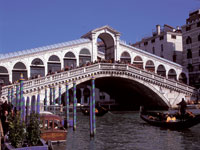 Venice OverviewElegant Venetian buildings and palaces peer over the ancient
maze of narrow streets and labyrinth of canals that make up this
unique city. Tourists naturally flock to Venice to experience its
inimitable charm. The downside of this can be felt in the narrow
streets and cramped piazzas of its sought-after areas. A good way
to get to know a more personal side of Venice is to saunter through
its romantic back streets and residential quarters. Venice rests on one of a series of 117 islands distributed
throughout the Venetian lagoon, at the northern end of the Adriatic
Sea. This strategic position conferred on Venice economic and
defensive advantages over its trading rivals. As the wealth of the
city increased and its population grew, the composition of the city
grew ever more dense and today only a handful of the islets that
constitute the historic centre are not entirely developed. The historic centre is divided into six quarters (
). These are: San Marco, Dorsoduro, San Polo,
Santa Croce, Cannaregio and Castello. The city's main thoroughfare
is the Grand Canal that intersects each district as it meanders
through the length of Venice, from the railway station to San
Marco. An alternative to walking the bewildering streets of Venice
is to cruise the waterways onboard the motorboat buses known as
. These are the less romantic but also less
expensive substitutes for the famous gondolas. Venice extends beyond its six
to the islands of Murano, Burano and Torcello.
These are known for glass and lace-making respectively, and
Torcello is noted for the magnificent Byzantine Basilica of Santa
Maria Assunta that rests on its soil. Trips by boat to the islands
provide a pleasant diversion from the busier historic quarters. |